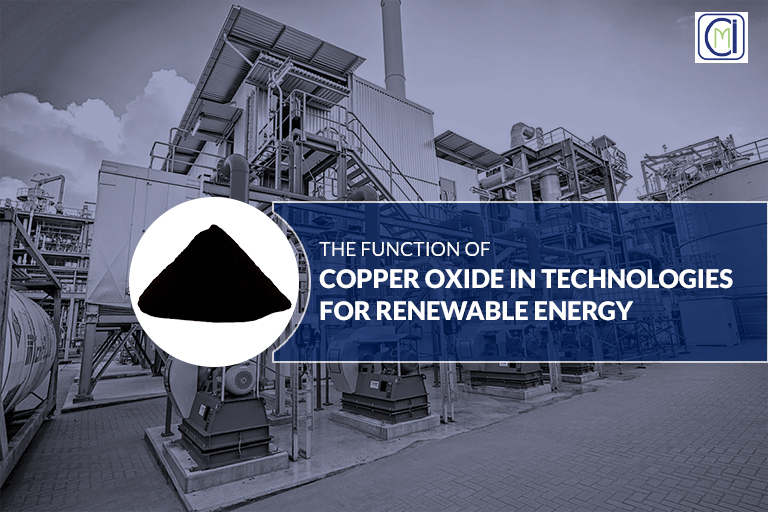
The Function of Copper Oxide in Technologies for Renewable Energy
As technology advances and our awareness of the environment heightens, the search for sustainable energy sources becomes increasingly crucial. Amidst this backdrop, copper oxide, a fine black powder with a wealth of applications, has emerged as an unsung hero. Especially when procured from a reputable Cupric oxide supplier in India, this compound's potential in renewable energy sectors is both significant and compelling.
Solar Cells
Did you know that the efficiency of a solar cell depends largely on the materials used in its construction? Copper oxide, for instance, plays a pivotal role in the development of photovoltaic cells. While traditional solar cells depend on silicon, copper oxide-based cells offer a cost-effective and efficient alternative.
- Economical Production: Unlike silicon, copper oxide is abundant and easy to produce, significantly reducing the cost of solar cell production.
- Flexibility in Design: Copper oxide-based solar cells can be thin and flexible, paving the way for innovations like bendable solar panels.
Energy Storage
For renewable energy to truly replace fossil fuels, the issue of energy storage must be addressed. Here too, copper oxide proves indispensable.
- Advanced Batteries:The search for next-gen battery technology has led researchers to explore the potential of copper oxide. Its properties facilitate higher energy storage and faster charging times.
- Superconductors: Copper oxide can be a crucial element in superconductors, which can transport electrical current without any resistance. This can revolutionize how energy is stored and transported.
Thermoelectric Generators
Thermoelectric materials can transform temperature differences directly into electricity. Here, copper oxide steps in with remarkable potential.
- Waste Heat Recovery:Industries generate vast amounts of heat that often go to waste. With copper oxide-based thermoelectric materials, this heat can be efficiently converted into usable energy.
- Eco-Friendly Air Conditioning: Modern air conditioners and refrigerators can benefit from these generators, leading to significant energy savings and reduced carbon footprints.
Hydrogen Production
Hydrogen is dubbed the fuel of the future, and for good reason. But how do we produce it cleanly and efficiently? Enter copper oxide.
- Photoelectrochemical Water Splitting:Using sunlight, copper oxide can help split water into hydrogen and oxygen. This provides a green method to produce hydrogen, a potential replacement for fossil fuels.
- Catalytic Reforming: Copper oxide acts as a catalyst, assisting in extracting hydrogen from organiccompounds and, further expanding the clean energy portfolio.
Biofuel Production
Biofuels represent a bridge between traditional fossil fuels and entirely green energy sources. Copper oxide plays a role in making biofuel production more efficient.
- Algae Processing: Algae can be processed into biofuel. Copper oxide catalysts help breakg down the biomass more effectively, ensuring higher yields.
- Efficient Ethanol Production: In the production of bio-ethanol, copper oxide aids in speeding up the conversion process, making it more energy-efficient.
Beyond Energy: The Multifaceted Applications of Copper Oxide
The story of copper oxide doesn't end with its contributions to the renewable energy sector. Diving deeper, we uncover a range of other fascinating uses that this compound brings to various industries.
Antimicrobial Properties
- Medical Marvel: Copper oxide-infused fabrics and materials are gaining traction in medical settings, as they can actively reduce bacterial and viral loads. This is especially valuable in high-risk areas such as ICUs andoperatingn theatres.
- Consumer Products: Many consumer goods, from socks to bed linens, are now integrated with copper oxide, taking advantage of its antibacterial properties to offer longer-lasting freshness and reduced odor.
Agriculture and Horticulture
- Fungicidal Functions: Copper oxide is a primary ingredient in several fungicides. These products help combat fungal diseases in crops, ensuring better yield and healthier produce.
- Root Growth Promotion: In certain controlled conditions, minute amounts of copper oxide can stimulate root growth, potentially leading to stronger and more resilient plants.
Glass and Ceramics
- Colouring Agent: Copper oxide, when added to glass or ceramics, can impart a beautiful green or blue hue. Artists and manufacturersoften utilize this property to craft visually striking products.
- Structural Integrity: In specific ceramic products, copper oxide acts as a flux, helping reduce the melting temperature and improving the final product's strength.
Electronics and Semiconductors
- Thin Film Transistors: Used in liquid crystal displays (LCDs), copper oxide plays a crucial role in the manufacture of certain thin film transistors.
- Gas Sensors: Copper oxide-based sensors can detect and measure gases like carbon monoxide, making them integral in many safety systems.
Catalysis Beyond Biofuels
- Chemical Synthesis: In various chemical reactions, copper oxide acts as a catalyst, accelerating the process and ensuring higher yields.
- Environmental Clean-up: As a catalyst, copper oxide assists in breaking down harmful organic compounds, aiding in processes like water treatment and air purification.
Conclusion
As we continue our journey towards a more sustainable and green future, the importance of materials like copper oxide cannot be understated. The potential applications in renewable energy and beyond make it a substance to watch out for.
If you are on the lookout for top-tier copper oxide or have queries about its potential applications, Meghachem is here to guide you. As one of the prominent suppliers of cupric oxide in India, we prioritize quality and sustainability in every grain of the product. Connect with us and embark on a sustainable journey with copper oxide by your side.
Frequently asked questions:
A. Copper oxide's semiconductor behavior and light-absorbing properties make it an excellent candidate for enhancing the efficiency of solar cells by capturing and converting sunlight into electricity.
A. Copper oxide's high theoretical capacity and cycling stability make it a potential material for improving the performance of batteries, particularly in lithium-ion battery systems.
A. Copper oxide's thermoelectric properties enable it to convert waste heat into electricity in thermoelectric devices, offering a way to recover energy and improve overall energy utilization.
